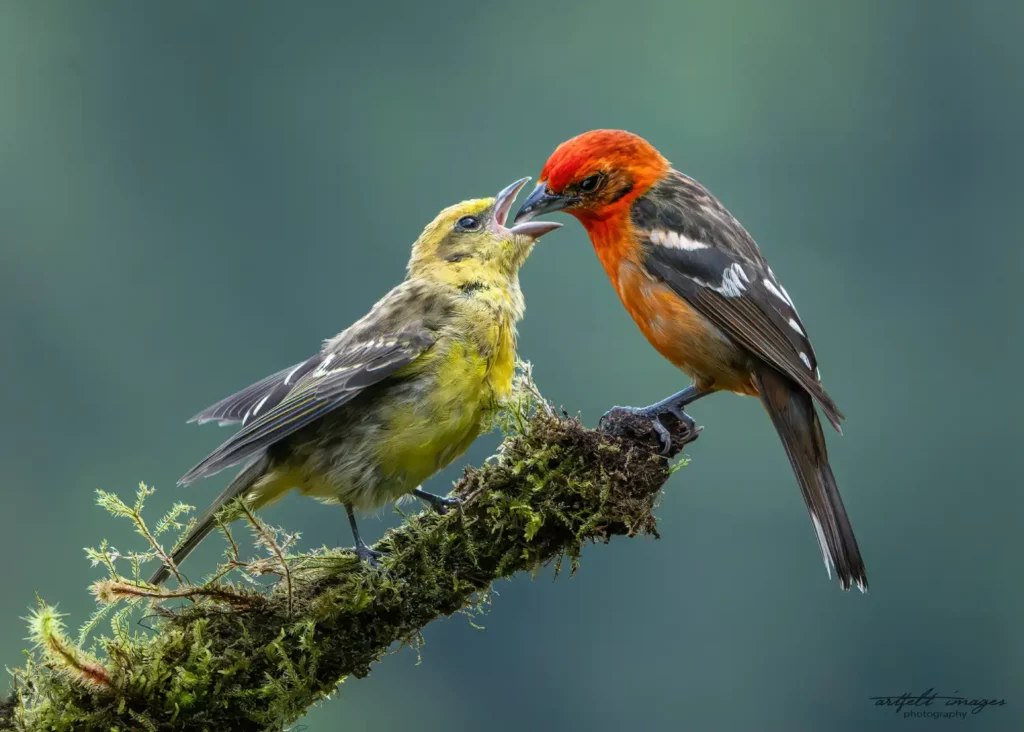Flame-colored Tanager

Piranga bidentata
Scientific Name
Cardinalidae
Family
Passeriformes
Order
Range and Habitat of Flame-colored Tanager
Geographic Range
The Flame-colored Tanager (Piranga bidentata) is primarily found in Mexico and Central America, ranging from northwestern Mexico south through Guatemala, El Salvador, Honduras, and into Nicaragua.
Migratory Patterns
Most populations in Mexico and Central America are resident year-round.
Preferred Habitat
Found primarily in foothill and highland forests, preferring oak forests.
Altitude Range
Flame-colored Tanagers typically inhabit mountain forests at elevations between 4,000-10,000 feet (1,200-3,000 meters).
Costa Rica Habitat
Best regions for sightings: The Talamanca Highlands, Braulio Carrillo National Park.
Conservation Status
Least Concern
Conservation Status
Population Status
Classified as not globally threatened. Healthy populations ranging from Mexico to Western Panama.
Conservation efforts
Although this species has adapted well to disturbed forests, efforts should be made to protect primary Oak and White Oak forests.
Primary Threats
Flame-colored Tanager Identification
How to Identify the Species
Rarity Level:
CommonBest Viewing Times:
Early Morning (Dawn - 8 AM), Evening (Dusk)
Size
18-19 cm
Plumage
Males are identifiable by their flame orange-red head and under belly, bold black and white wing bars, and dusky tail. Females have the same markings but heads and underbellies are bright yellow.
Distinctive Features
Both male and females sport a distinctive brown patch under the eye.
Sexual Dimorphism
Males have flame orange-red head and under belly while the females have yellow parts.
Diet and Feeding Behavior
Primary Diet
- Prefers arthropods, berries and small fruit.
Foraging Techniques
- Flame-colored Tanagers glean insects from foliage, hover-pick from leaf undersides, pursue flying insects, and methodically eat berries primarily in oak and pine canopies.
Feeding Times
- They forage most actively during early morning and late afternoon, with reduced midday activity, especially during hot weather.
Behavior Patterns
Flame-colored Tanager
Social Structure
Flame-colored Tanagers typically live as solitary birds or in breeding pairs, occasionally joining mixed-species flocks outside breeding season.
Song and Vocalization
Males sing a series of sweet, robin-like warbling phrases while females produce shorter call notes; both sexes use sharp “chip” calls for alarm and contact.
Courtship and Mating Ritual
The male performs elaborate flight displays with puffed plumage and extended wings, offers food to the female, and engages in synchronized perching behaviors before forming monogamous seasonal pairs.
Territoriality
Male Flame-colored Tanagers establish and vigorously defend breeding territories through song, display flights, and occasional physical confrontations with intruders, with territory size typically ranging from 2-5 acres depending on habitat quality.
Birdwatching Tips
Best Locations for Spotting Flame-colored Tanager
Best regions for sightings: The Talamanca Highlands, Braulio Carrillo National Park.

Best Time of the Year
This bird is common throughout the year in the Talamanca Highlands.
Common Behavior
Early morning and late afternoon are the best times for spotting this bird.
Recommended Gear
Breeding and Nesting Behavior
Breeding Season
Flame-colored Tanagers typically breed from April to July
Nesting Sites
The nest is typically placed in the fork of a tree branch, usually in pine or oak trees, at heights of 15-40 feet (4.5-12 meters) above the ground.
Clutch Size
A typical clutch consists of 2-4 eggs
Incubation Period
Parental Care
Both parents participate in caring for the young, though the female does most of the incubation. After hatching, both parents feed the nestlings. The young birds typically leave the nest (fledge) after 12-14 days but continue to be fed by the parents for several more weeks as they learn to forage independently.
Did You Know?
What does the Flame-colored Tanager eat?
Diet consists of small arthropods, a variety of berries, and prefers the fruit of the ficus tree.
How can I identify a Flame-colored Tanager?
The male is a bright red-orange, has a brown patch under the eye, and distinct black and white wing bars. The Female is the same except Yellow.
When is the best time to see the Flame-colored Tanager in Costa Rica?
Since it is a non-migratory bird, it can be seen year-round, though dawn and dusk offer the best chances. The Talamanca Highlands is the most reliable location.